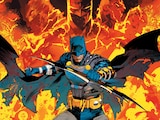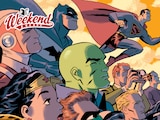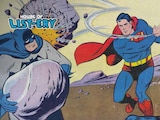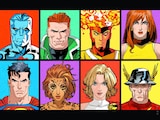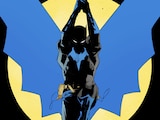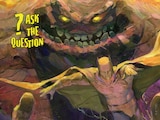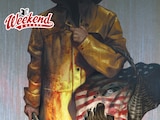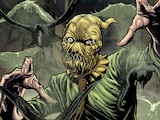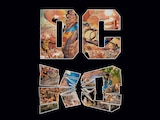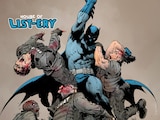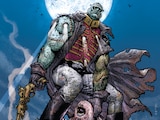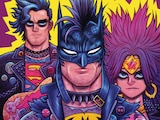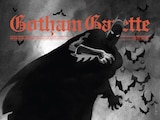Ever since Michael Keaton went toe-to-toe with Jack Nicholson in 1989, it’s been a tradition to discuss the comic book storylines that directors have drawn upon to realize their version of the Dark Knight. Tim Burton’s Batman was directly influenced by the two-sides-of-the-same-coin theme from The Killing Joke. Batman Begins promoted the Dennis O’Neil and Dick Giordano short story “The Man Who Falls,” while The Dark Knight paid homage to The Long Halloween and The Dark Knight Rises served as a spiritual amalgamation of The Dark Knight Returns, Knightfall and No Man’s Land respectively.
With The Batman, it’s time to do it again. Matt Reeves’ much anticipated movie focuses on a Batman who’s in his second year of operation—in other words, he’s a Caped Crusader who’s donned the cowl but hasn’t quite perfected his MO to truly become the hero of Gotham. A few stories have been noted by director Matt Reeves and star Robert Pattinson as inspirations for their version of Batman, but if you want the breadth of early days adventures, look no further than this list of Batman stories taking place during his second year!
Batman: The Man Who Laughs
Batman: The Man Who Laughs serves as a modern-day reimagining of Batman’s first encounter with the Joker. It’s both a retelling of the original 1940 story found in Batman #1 and a sequel to comics like Batman: Year One that are set at the very beginning of Batman’s career. Both Batman and Captain Gordon are pushed to the brink of their deductive skills in figuring out the Joker’s next move as he threatens his victims on live television 24 hours before carrying out their murders via the use of his famous Joker toxin, rendering their dead corpses with rictus-grins. The Joker threatens wealthy businessmen and grips the entire city in widespread panic with his seemingly godlike ability to defy the police’s best efforts.
Written by Ed Brubaker and illustrated by Doug Mahnke, this retelling excises Robin and focuses more on Batman and Gordon’s efforts in deciphering who the Joker is and what his plans are for Gotham. The Joker’s “Red Hood” origin is nodded to, as Batman is forced to reconcile with a city that offers freaks and monsters as antagonists for his crimefighting skills. He’d only prepared for normal criminals. The Joker forces him to expect the unexpected.
Batman: The Long Halloween
The seminal thirteen-part mystery has gained a lot of public attention over the years, from its influencing Christopher Nolan to the most recent animated adaptations, and it’s a major influence on Reeves’ The Batman.
While The Long Halloween is set early in Batman’s career, his classic rogues gallery has been established, including minor villains like Calendar Man. Catwoman presents herself as an elusive thief for whom Batman shares a mutual spark, and the Falcone Crime Syndicate (first appearing in Batman: Year One) vies to maintain its domination over the Gotham City rackets. How fortunate, then, that those members of the mob are systematically getting killed off on the dates of various holidays?

Once a month, the killer dubbed as “Holiday” strikes, dispatching family members, assistants and allies of the Falcone mob. This bizarre series of assassinations spurs an alliance of Batman, Captain Gordon and District Attorney Harvey Dent, who together work to apprehend Holiday while putting the Falcone mob down for good.
Over the course of the story, certain revelations are made which make solving the mystery harder for our heroes to accomplish. For Gordon, the killings require constant time away from his family. For Batman, his detective skills are pushed to their breaking point, and he must master them to stop Holiday. For Harvey Dent, the dichotomy of preventing the murder of mobsters tears his sense of justice in two, and he frequently is suspected as a suspect. It’s not until his fateful meeting with a bottle of acid that Dent’s true destiny as a member of Gotham’s underworld makes things crystal clear, and the line between good and evil blurs ever further for our heroes.

Batman and the Monster Men/Batman and the Mad Monk
Like The Man Who Laughs, the two-tale feature by writer and artist Matt Wagner serves as retellings of Batman’s Golden Age adventures. Set after Batman: Year One, Batman and the Monster Men depicts the Caped Crusader’s first encounter with Professor Hugo Strange and his bizarre experimentations that result in gigantic monster men. More incisive with the benefit of hindsight than the original story from Batman #1, Batman and the Monster Men features Julie Madison and her father Norman as victims swept up in the world of crime and costumes. Norman Madison is a businessman indebted to the mobster Sal Maroni—the gangster partially responsible for Two-Face. Julie Madison is reimagined as a young law student whom Bruce genuinely falls for, to the point that he begins considering bringing his war on crime to an end. Bruce hopes to have a future with Julie, but isn’t yet ready to share his secret with her, which creates suspicion in Julie.
This carries over into Batman and the Mad Monk, a reimagining of Detective Comics #31-#32. In this version of the story, the eponymous Monk is not a hypnotic vampire but the descendant of a wealthy Gotham family who traveled abroad and returned home to start a cult. The exact nature of his abilities are unknown, but Batman is resistant to believe in the supernatural. Still, that doesn’t stop him from preparing for the worst, and we see him create silver-tipped batarangs.

These stories further develop the early Batman into what he will become down the road. Bruce battles with mad scientists and genetically engineered mutants. He battles cults and deals with extraordinary circumstances beyond those of typical mobsters. Throughout the duology, he realizes that relationships are unbecoming of a man dedicating his life to the eradication of crime. His romance with Julie sours, and by the end of Batman and the Mad Monk, she leaves Bruce and joins the Peace Corps.
Batman: Ego
Of the several comics listed as an influence by Reeves and Robert Pattinson, Batman: Ego may just be the most unique. A one-shot by the late, great Darwyn Cooke, this story served as a catch-all embodiment of Cooke’s favorite elements of the Batman mythos.
After the battle between Batman and the Joker results in the suicide of a mobster, Bruce returns to the cave ready to give into despair at the futility of his mission. Suddenly a ghost-like vision of his Batman persona appears to him, mocking his depression and taking him through the processes that created his will to fight in the first place.
A masterclass in comic book storytelling, Batman: Ego revisits Bruce’s childhood trauma, his love for his parents, his destroyed friendship with Harvey Dent and his dual persona as both millionaire playboy and the Dark Knight. Confronting his use of a child sidekick and his code against killing, the Batman monster represents the extremes of Bruce’s psyche, pushing his sanity and his conviction to their limits, before recommitting him to the vow he made to not just inspire fear in the hearts of criminals, but to inspire hope in the citizens of Gotham. Far too underrated in the pantheon of Batman classics, it’s high time that Batman: Ego be given its rightful place in the very best Batman stories of all time.
The Batman, directed by Matt Reeves and starring Robert Pattinson, Zoe Kravitz and Colin Farrell as the Penguin, is in theaters on March 4. Be sure to check out our official movie page for all the latest news, articles and videos.
Prepare for The Batman by reading Batman: The Man Who Laughs, Batman: The Long Halloween, Batman and the Monster Men and Batman: Ego right now on DC UNIVERSE INFINITE!
Donovan Morgan Grant writes about comics, graphic novels and superhero history for DCComics.com. Follow him on Twitter at @donoDMG1.





